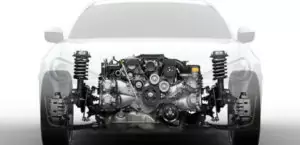The Jaguar AJV6D 3.0-liter V6 diesel engine has been assembled at the company’s plant since 2009 and is still installed on many well-known models of the British concern, such as the XJ, XF or F-Pace. The same power unit is installed on Land Rover SUVs, but under the symbol 306DT. This motor is a kind of diesel 3.0 HDi.
Specifications
| Production years | since 2009 |
| Displacement, cc | 2993 |
| Fuel system | Common Rail |
| Power output, hp | 240 – 300 |
| Torque output, Nm | 500 – 700 |
| Cylinder block | cast iron V6 |
| Block head | aluminum 24v |
| Cylinder bore, mm | 84 |
| Piston stroke, mm | 90 |
| Compression ratio | 16.1 |
| Features | DOHC |
| Hydraulic lifters | yes |
| Timing drive | chains & belt |
| Phase regulator | no |
| Turbocharging | Garrett GTB1749VK + GT1444Z |
| Recommended engine oil | 5W-30 |
| Engine oil capacity, liter | 5.9 |
| Fuel type | diesel |
| Euro standards | EURO 4/5 |
| Fuel consumption, L/100 km (for Jaguar XF 2018) — city — highway — combined |
7.0 5.2 5.9 |
| Engine lifespan, km | ~280 000 |
The engine was installed on:
- Jaguar XF 1 (X250) in 2009 – 2015; XF 2 (X260) since 2015;
- Jaguar XJ 8 (X351) in 2009 – 2019;
- Jaguar F-Pace 1 (X761) since 2016.
Disadvantages of the Jaguar AJV6D engine
- Almost all the problems of this diesel engine are somehow related to lubrication pressure;
- In the early years, a weak oil pump was installed, which led to the cranking of the liners;
- Then the pump was changed, but the oil pressure still needs to be closely monitored;
- Also often here the grease oozes through the heat exchanger and the front crankshaft oil seal;
- The weak points of the motor include piezo injectors and a plastic intake manifold.






